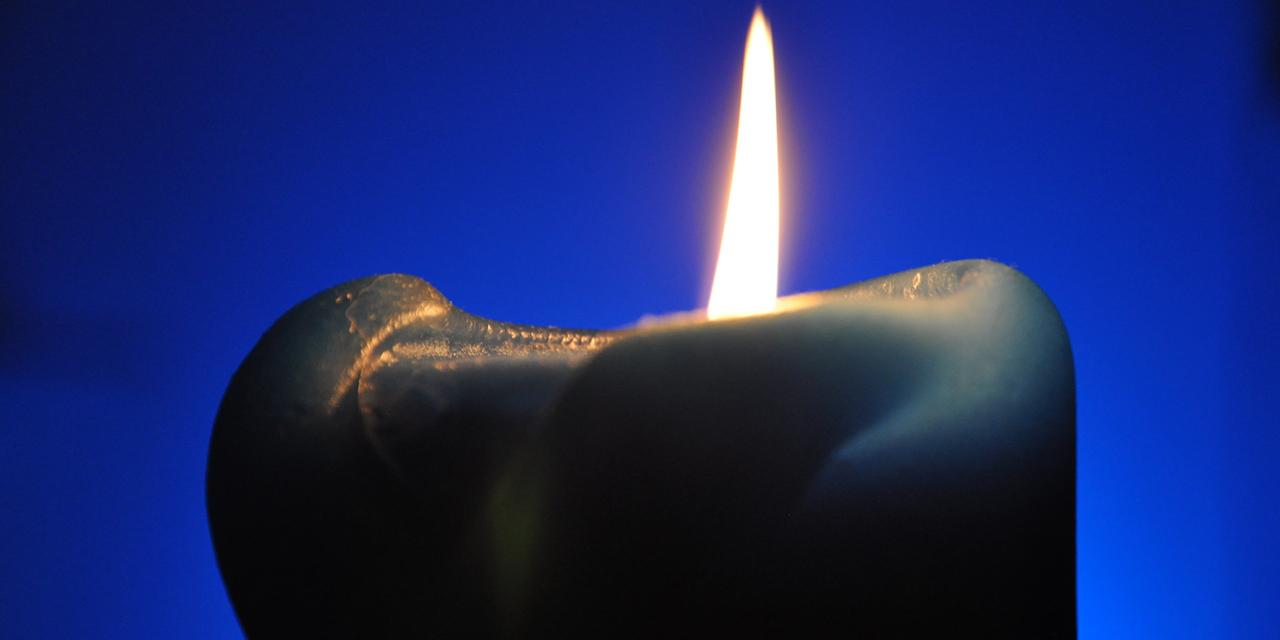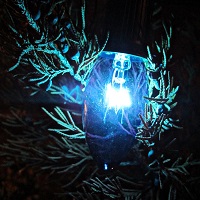This story defines each service type, briefly profiles a worshiping community, describes common elements among churches that use a given service type, and gives song suggestions and resources for you to plan your own service. Most of the songs listed below can be found on Hymnary.org, SongSelect, or YouTube.
Blue Christmas
| 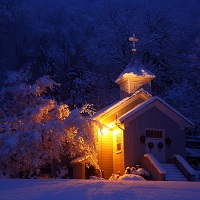 | 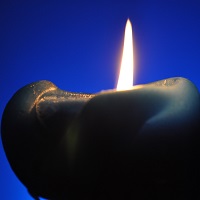 |
What it is: Churches host Blue Christmas services, sometimes known as Longest Night services, because Advent and Christmas aren’t happy times for everyone. Blue Christmas services pastorally help people bring their pain, whether personal or communal, to God in worship. Coming together helps people validate their sadness yet experience the hope of Christmas.
Who does it: Bradley Hills Presbyterian Church in Bethesda, Maryland, holds two Blue Christmas services on a Wednesday before Christmas. They start planning a month ahead for a midday service (for people who don’t like to drive at night) and a slightly longer early evening service. Deacons phone people who’ve experienced a recent loss, invite them, offer rides, and host a reception after each service.
“It’s super meditative, deeply spiritual,” says David Gray, the church’s pastor and head of staff. “People so appreciate it. We get a lot of community people, from older ones who’ve lost loved ones to younger ones who feel disconnected from church to others who simply resonate with Taizé-like music, darkness, and silence. .
“I plan it with our director of music, worship leaders, and congregational care folks. Blue Christmas takes place in our columbarium [place for loved ones’ remains]. It has excellent acoustics and a beautiful resurrection window. We line the room and communion table with candles, always Advent blue. We light an Advent wreath during the call to worship and invite people forward to light candles from the Christ Candle in honor of loved ones or special causes. Seeing the table after all the candles are lit by folks is the best part.
“Then we move to prayer, short Scripture readings, and short songs or verses of longer Advent hymns. We have moments of silence, a litany, and a devotional of five to eight minutes. We also do communion by intinction (dipping the bread into the cup). People can come forward or we’ll bring the elements to them,” Gray says.
Common elements: Many Blue Christmas services have a litany of lighting four candles to remember whom or what we’ve loved and lost; to redeem wounds by offering pain to God; to ask for courage for all who suffer; and to take hold of God’s promise to be with us as we wait till all things are made new. Worshipers often receive something as they enter, perhaps a candle to light, a blue or purple carnation to lay on the communion table, or a slip of paper on which to write a prayer before placing it in a manger. A reception afterwards sometimes includes trained counselors or people ready to invite attendees to a Christmas meal.
Song suggestions: “Comfort Your People, Lord,” “Don’t Be Afraid,” “For You, O Lord, Our Souls in Stillness Wait,” “How Can We Sing a Joyful Song?”, “In the Bleak Midwinter,” “In the Lord I'll Be Ever Thankful,” “O Come, O Come, Emmanuel,” “O Little Town of Bethlehem,” “O Lord, Hear My Prayer,” and “Stay with Me.” More contemporary choices (better for solos than congregational singing) include “Have Mercy On Me” by Porter’s Gate, “Letting Go” by Sandra McCracken, “On the Way” by Val Nebbia, “Praise You in This Storm” by Casting Crowns, and “The Weight of the World” by Katy Bowser and Kenny Hutson.
Resources to plan your own: Clergy Leadership Institute’s Blue Christmas resources include page links to sample services and meditations. Explore re:Worship for Blue Christmas calls to worship, prayers, litanies, benedictions, and visual ideas. This very pastoral Episcopal Blue Christmas service includes time for people to request healing prayer with laying on of hands and anointing with oil. Watch a Blue Christmas video from DisciplesNet, an online church.
Christmas Pageant
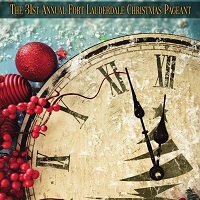 | 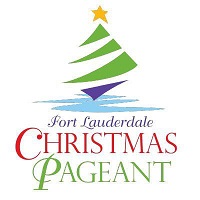 | 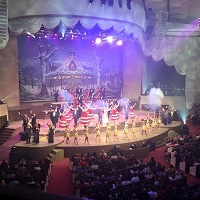 |
What it is: For centuries, the church was a major patron of arts in the Western world. You might see medieval mystery plays as forerunners of today’s Christmas pageants. Both bring together music, drama, and (sometimes) dance to (often) entertain people while emotionally connecting them with the mysteries of God. Today’s Christmas pageants often include participants of many ages, especially children. They range in size from major Broadway-style spectacles to humble skits with kids in bathrobes.
Who does it: First Baptist Church in Fort Lauderdale, Florida, began doing a big Christmas pageant in 1984. The two-and-a-half-hour event now runs fourteen times over three weekends in the church’s Downtown Events Center. The pageant is filmed for broadcast around the world and has won many awards, including three Emmys. Themes vary by year, but the first half of each pageant focuses on entertainment while the second half retells the story of Jesus from birth to resurrection.
Creative Arts Director David Gross describes the pageant as a two-fold ministry. The show itself is designed to clearly present the gospel so that “the unsaved have their lives changed forever.” But the second purpose is to minister to and through more than a thousand First Baptist members who volunteer in the cast and crew. “During our rehearsals we have opportunities to disciple one another via prayer, Scripture, and fellowship,” Gross says.
At First Baptist, planning goes on from February through mid-December. A recent “Christmas Pageant Rally Guide” shows the scope and structure required to plan an event of this size.
In direct contrast, many churches create simple pageants based on words from the Bible. Participants read from cards or perform silently as a narrator reads the Christmas story. Therese E. Cho, a pastor at St. John’s Presbyterian Church in San Francisco, California, came up with the “No Stress, No Fuss Christmas Pageant.” Everyone gets to decide on the spot what part to play—and it’s fine if there’s more than one Mary or Joseph.
Common elements: Christmas pageants offer many ways for many people to experience themselves as part of God’s story. The combination of costumes, music, and movement helps people of all ages sink the Christmas story into their muscle memory. It’s easy to invite a friend or neighbor to attend or even participate in a Christmas pageant.
Song suggestions: “Amen, Amen” (spiritual), “Angels, We Have Heard on High,” “Children, Go Where I Send You,” “Friendly Beasts,” “Gloria, Gloria, Gloria,” “Go Tell It on the Mountain,” “Hark, the Herald Angels Sing,” “Huron Carol,” “Joy to the World,” “Mary, Did You Know?”, “Mary Had a Baby,” “Rise Up, Shepherd, and Follow,” “Star-Child,” “Sweet Little Jesus Boy,” “The Hunger Carol,” “We Three Kings,” “What Child Is This?”, and “While Shepherds Watched Their Flock.” Also check out this free collection of multilingual Christmas songs about peace from World Council of Churches.
Resources to plan your own: Building Faith, a ministry of Virginia Theological Seminary, offers Christmas pageant ideas, tips, and free scripts. Download “New Ways of Doing the Christmas Pageant” from Practical Church Resources.
Las Posadas
“Acting out Mary and Joseph’s story is a good way to share solidarity with people affected by border issues today. It helps us practice how to welcome and provide care to others, to strangers. The Las Posadas fiesta reminds us that, even if we don’t have much, we can share what we have.”
.jpg?language_id=1)
What it is: The Spanish word posada means “inn” or “lodgings.” In the 1500s, Catholic priests brought the Las Posadas Advent processionals from Spain to Mexico. This reenactment of Mary and Joseph’s search for shelter has become deeply rooted in Mexican culture. The celebration spread to Guatemala and Cuba. Many Spanish-speaking and bilingual Protestant churches observe it in the U.S. Some do Las Posadas as a novena for the nine nights from December 16–24. Others do only a single Posada.
Every Posada begins with two groups on either side of a door. The pilgrims outside with Mary and Joseph beg to enter. Those inside with the innkeeper refuse, saying, “I can’t open up. You might be a robber.” Finally, the outsiders find insiders willing to let them in from the cold. Then everyone shares prayer, singing, food, and fun—joyfully living out the gospel message of welcome and hospitality.
Who does it: “Las Posadas have always been a part of who we are,” says Frank Hernandez, who was associate pastor at St. Pius X Catholic Community before moving across town to St. Mark Parish in El Paso, Texas. “It’s a way for the St. Pius X community to come together to reenact Mary and Joseph trying to find an inn that will take them in.
He explains that St. Pius X follows the novena—nine nights of Las Posadas before Christmas. Different ministries or ministry clusters take charge of a night. Some people go to as many as they can at church. People also have Posadas in their neighborhoods, knocking on doors of three pre-chosen homes. “To do a Posada, at minimum you need someone to gather people and divide them into inside and outside groups. You also need a vocalist, song sheets, and, if possible, a musician, usually a guitarist,” Hernandez says.
“When Father Arturo Bañuelas was at St. Pius X, he made sure to talk about how acting out Mary and Joseph’s story is a good way to share solidarity with people affected by border issues today. It helps us practice how to welcome and provide care to others, to strangers. The Las Posadas fiesta reminds us that, even if we don’t have much, we can share what we have,” Hernandez says.
Even breaking the piñata has religious meaning. Hernandez says that Las Posadas fiestas use seven-pointed piñatas to represent “the seven deadly sins overcome through the birth of Jesus.”
Common elements: Every Posada has a costumed Mary, Joseph, and innkeeper; three doors; the Posadas song; and a fiesta with a piñata and the piñata song. The most traditional Posadas start outdoors with Mary on a donkey and pilgrims in costume. Pilgrims knock at three doors and sing back and forth through the first two closed doors till the third is opened. Hernandez says that, depending on how cold the night is, Posadas at St. Pius X sometimes start in a hallway.
Song suggestions: The traditional Posada song, “Canto para pedir posada” (song to ask for shelter), begins with the outside and inside group singing alternate verses. When the door opens, the tune changes, and everyone sings together “Entren santos peregrinos” (enter holy pilgrims). Although everyone uses the same two tunes, Spanish and English texts vary somewhat. You can find side-by-side texts here and here, along with guitar chords and melody notation. People sing this short chorus from “La piñata,” while blindfolded kids swing at the piñata. English translations vary, but here’s one bilingual version.
Resources to plan your own: Get sheet music, detailed checklists, food suggestions, sermon ideas, social justice tie-ins, and more by downloading these excellent planning guides: “Las Posadas Navideñasas” by Krysia J. Heimer; “Room in the Inn” by Hugo Olaiz and Yuri Rodríguez; “Las Posadas” handbook by Fiesta Cristiana. Read the children’s books The Night of Las Posadas by Tomie de Paola and Dale, Dale, Dale . . . A Fiesta of Numbers (bilingual) by René Saldaña Jr.
Lessons and Carols, or the Festival of Nine Lessons and Carols
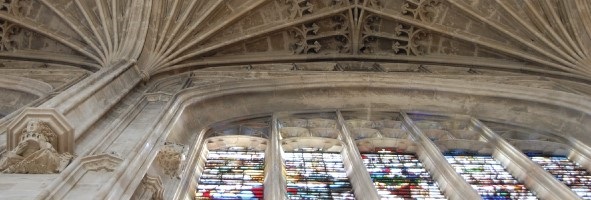
What it is: In the late 1800s, an Anglican cathedral in England patterned its Christmas Eve service as a series of Scripture readings, each followed by a choral anthem or congregational song. In 1918, King’s College, Cambridge, used the Festival of Nine Lessons and Carols format for its Christmas Eve service. The BBC began broadcasting it in 1928, and the tradition has spread around the world. Some congregations do lessons and carols on the first or second Sunday of Advent.
Many templates and sample services with suggestions for music and Scripture can be found online. Worship pastor Zac Hicks notes that lessons and carols can fit into any worship tradition, including charismatic, Pentecostal, or contemporary. Catholic and Orthodox churches use lessons and carols too.
Who does it: Hood Theological Seminary in Salisbury, North Carolina, began doing lessons and carols while Albert Aymer was its president and Karen Lucas was campus musician. Hood is the seminary of the African Methodist Episcopal Zion Church, a historically black denomination in the United States.
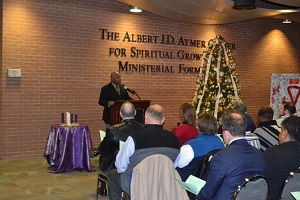
Mary Love, an expert in African American church education resources who teaches at Hood, says planning the school’s lessons and carols service begins in October or early November. “We prepare a large Chrismon tree and other appropriate decorations to set the atmosphere,” she says. “The president assigns different lesson readers to reflect the diversity in the community, and the Student Government Association has a vital role as well. Usually a faculty member brings the homily. Because we experience time constraints, we modified the service to use seven lessons rather than nine and don’t always sing all stanzas of each carol.
“Holding lessons and carols at the end of first semester allows us to share a closing worship service with students from both M.Div. tracks, Love adds. “We encourage them to bring their family and friends and also invite the Salisbury community to attend. We always share a community meal before the service.”
Common elements: Most start with a sung processional and bidding prayer followed by a set of nine lessons and carols. Some services do six or seven lessons. A few include a homily. The Scripture lessons trace the themes of hope for a Savior, Christ’s birth, and his incarnation. Many services follow the classic King’s College lessons, which begin in Genesis 3 with the fall. In recent decades, some congregations start instead with the good news of creation or incarnation, basing the first lesson on Genesis 1, Job 38, Psalm 104, Isaiah 9, or John 1.
Song suggestions: For traditional music in a lessons and carols service, check out this Reformed Worship article, the complete list from King’s College, and suggestions from St. James Music Press. Contemporary options include “Beautiful Baby Boy,” “God With Us,” “Labor of Love,” “Magnificat,” “So Long, Moses,” and “The Unbelievable.”
Resources to plan your own: Use or adapt lessons and carols that are family friendly, have a creation theme, or come from New Zealand or South Africa. The UK-based Mission and Theology Group offers a guide that explains the nine traditional readings that’s especially useful for lessons and carols visitors who aren’t regular churchgoers. Compare archived programs from King’s College, Cambridge, and Calvin Institute of Christian Worship. The latter includes themes such as angels, evangelists, the Holy Spirit, justice, peace, and the psalms. Read William P. Edwards’ book The Festival of Nine Lessons and Carols, a history of the beloved King’s College Christmas Eve service.

